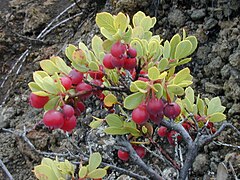Vaccinium reticulatum
This article includes a list of general references, but it lacks sufficient corresponding inline citations. (July 2018) |
| Vaccinium reticulatum | |
|---|---|

| |
| Scientific classification | |
| Kingdom: | Plantae |
| Clade: | Tracheophytes |
| Clade: | Angiosperms |
| Clade: | Eudicots |
| Clade: | Asterids |
| Order: | Ericales |
| Family: | Ericaceae |
| Genus: | Vaccinium |
| Species: | V. reticulatum
|
| Binomial name | |
| Vaccinium reticulatum | |
| Synonyms[1] | |
 Vaccinium reticulatum fruits, Maui | |||||||||||||||||||||||||||||||||
| Nutritional value per 100 g (3.5 oz) | |||||||||||||||||||||||||||||||||
|---|---|---|---|---|---|---|---|---|---|---|---|---|---|---|---|---|---|---|---|---|---|---|---|---|---|---|---|---|---|---|---|---|---|
| Energy | 117 kJ (28 kcal) | ||||||||||||||||||||||||||||||||
6.84 g | |||||||||||||||||||||||||||||||||
0.22 g | |||||||||||||||||||||||||||||||||
0.38 g | |||||||||||||||||||||||||||||||||
| |||||||||||||||||||||||||||||||||
| †Percentages estimated using US recommendations for adults,[2] except for potassium, which is estimated based on expert recommendation from the National Academies.[3] | |||||||||||||||||||||||||||||||||
Vaccinium reticulatum, known as ʻōhelo ʻai in Hawaiian, is a species of flowering plant in the heather family, Ericaceae, that is endemic to Hawaii. It grows at altitudes of 640–3,700 m (2,100–12,140 ft) on lava flows and freshly disturbed volcanic ash on Maui and Hawaiʻi, and less commonly on Kauaʻi, Oʻahu, and Molokaʻi. Adaptations to volcanic activity include the ability to survive ash falls of over 25 cm (9.8 in) depth.
Description
[edit]ʻŌhelo ʻai is a shrub usually 0.1–1.3 m (3.9 in – 4 ft 3.2 in) tall, rarely up to 2 m (6.6 ft). The leaves are evergreen, spirally arranged, leathery, oval, 1–3 cm (1⁄2–1+1⁄4 in) long, red when freshly emerging, then green or green with reddish patches. The flowers are bell-shaped, 8–12 mm (5⁄16–1⁄2 in) long, variable in color, red to yellow or pink.
Fruit
[edit]The fruit is an edible berry 8–14 mm (0.31–0.55 in) diameter, ranging in color from blue to purple to red to orange to yellow. The color does not necessarily indicate the ripeness of the berries. The berries taste somewhat similar to the related cranberries, less ripe ones being tart, while ripe berries are quite sweet but bland. They are an important food source for the nēnē (Branta sandvicensis); the seeds are dispersed in the birds' droppings (endozoochory).
Uses
[edit]Oligomeric proanthocyanidins (OPC) can be obtained by the means of V. pahalae in vitro cell culture.[4]
See also
[edit]References
[edit]- ^ USDA, NRCS (n.d.). "Vaccinium reticulatum". The PLANTS Database (plants.usda.gov). Greensboro, North Carolina: National Plant Data Team. Retrieved 2018-07-18.
- ^ United States Food and Drug Administration (2024). "Daily Value on the Nutrition and Supplement Facts Labels". FDA. Archived from the original on 2024-03-27. Retrieved 2024-03-28.
- ^ National Academies of Sciences, Engineering, and Medicine; Health and Medicine Division; Food and Nutrition Board; Committee to Review the Dietary Reference Intakes for Sodium and Potassium (2019). Oria, Maria; Harrison, Meghan; Stallings, Virginia A. (eds.). Dietary Reference Intakes for Sodium and Potassium. The National Academies Collection: Reports funded by National Institutes of Health. Washington, DC: National Academies Press (US). ISBN 978-0-309-48834-1. PMID 30844154. Archived from the original on 2024-05-09. Retrieved 2024-06-21.
- ^ Kandil, F. E.; Song, L.; Pezzuto, J. M.; Marley, K.; Seigler, D. S.; Smith, M. A. L. (2000). "Isolation of oligomeric proanthocyanidins from flavonoid-producing cell cultures". In Vitro Cellular & Developmental Biology - Plant. 36 (6): 492. doi:10.1007/s11627-000-0088-1. S2CID 25781920.
- Plants of Hawaii Volcanoes National Park: Vaccinium reticulatum
- "Invasion and Recovery of Vegetation after a Volcanic Eruption in Hawaii (Chapter 6)". NPS.gov (U.S. National Park Service). 1998-04-24. Retrieved 2018-07-06.
- "Vaccinium reticulatum - Plants of Hawaii". Starr Environmental. Retrieved 2018-07-06.
- "ITIS Standard Report Page: Vaccinium reticulatum". Interagency Taxonomic Information System (ITIS). Retrieved 2018-07-05.
External links
[edit]- "ʻŌhelo". Native Hawaiian Plants. Kapiolani Community College. 2010-06-10. Archived from the original on 2010-06-10. Retrieved 2010-07-11.
- "Vaccinium reticulatum". Hawaiian Native Plant Propagation Database. University of Hawaiʻi at Mānoa.
- "ohelo, ohelo kau laau (V. calycinum), olelo ai (V. reticulatum)". Hawaii Ethnobotany Online Database. Bernice P. Bishop Museum.
